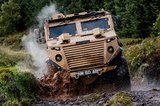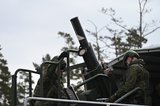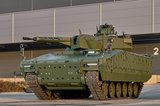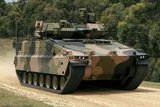The British Army’s Land Mobility Programme – all change but no progress?
The UK’s Land Mobility Programme, an effort to replace thousands of British Army vehicles, may be about to undergo a radical change in direction.
Lockheed Martin's Warfighters' Simulation (WARSIM) programme delivered realistic division Warfighter results during its debut in a recent command post exercise conducted by the US Army's Second Infantry Division (2ID) and the Republic of Korea Army.
Designed to integrate simulations into the Army's full-spectrum training plans, WARSIM enabled a training scenario for battle commanders, battle staffs, and other units in South Korea, simultaneously with the US Army's Combined Arms Center at Fort Leavenworth, Kan., and its Combined Arms Support Command at Fort Lee, Va. More than 200 US and Korean role-players participated in the exercise, using WARSIM to execute orders of commanders at the brigade and division level.
"It simulates the lethal and complex interactions of the battlefield and integrates ground, air, ballistic missile and intelligence models," said Markee White, Lockheed Martin WARSIM program manager. "WARSIM's ease of use was demonstrated by how quickly the Republic of Korea Army participants were able to use the simulation in a coalition, multi-lingual environment."
The 2ID was the first Army division to use WARSIM to successfully achieve their training objectives. WARSIM, which was originally initiated under a contract in 1996, is designed to simulate all levels of conflict - from major theater-level operations to stability and support operations at the brigade, joint and coalition level. WARSIM supports these exercises for US Army, joint and coalition training. Lockheed Martin developed laptop, transportable and battle simulation center configurations of WARSIM that can be tailored for specific training needs. The first system delivery to PEO STRI took place in January 2005. Development work, post deployment software support, additional fieldings and Army Exercise support will continue through September 2011. The program value was $419 million through 2009.
Source: Lockheed Martin

The UK’s Land Mobility Programme, an effort to replace thousands of British Army vehicles, may be about to undergo a radical change in direction.

The Land Mobility Programme is the biggest UK opportunity for the next few decades if it all falls into place. Companies have been filling their dance cards as milestones approach in the hope they are not the mirages of the past.

The war in Ukraine has made it clear: the battlefield waits for no one. Military operations now take place in fast-paced environments, and speed is not just about the fight itself – it is about the entire ecosystem of warfare.

Romania’s effort to buy infantry fighting vehicles is expected to include five configurations: a standard platform with a 30mm autocannon, a command variant, an armoured recovery vehicle, a medical evacuation vehicle and a 120mm self-propelled mortar.

Team LionStrike has demonstrated its offering for the British Army’s Land Mobility Programme with plans to bid the Chevrolet Silverado and two variants of the platform: the Infantry Squad Vehicle and General Support Utility Platform.

South Korea’s particular geopolitical situation and threat environment has created a defence industry ecosystem of substantial size and breadth.